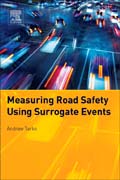
Measuring Road Safety Using Surrogate Events provides researchers and practitioners with the tools they need to quickly and effectively measure traffic safety. Traditional crash-based safety analyses are being undermined by today's growing use of intelligent vehicular and road safety technologies. Crash surrogates--or near misses--can be more effectively used to measure the future risk of crashes. Measuring Road Safety Using Surrogate Events advances the idea of using these near-crash techniques to deliver quicker and more adequate measurements of safety. The book explores the relationships between traffic conflicts and crashes using an extrapolation of observed events rather than post-crash data, which is significantly slower to obtain. It delivers sound estimation methods based on rigorous scientific principles, offering compelling new tools to better equip researchers to understand road safety and its factors. Consolidates the latest thinking from disparate places into one resourceEstablishes a consistent use of key terms, definitions, and concepts to help codify this emerging fieldNumerous application-oriented case studies throughoutLearning aids include chapter objectives, glossary, and links to data used in examples INDICE: 1. Crash Phenomenon 2. Crash-Based Safety Measurement 3. Crash-Surrogate Events 4. Observing Surrogate Events Techniques 5. Connecting Surrogate Events with Crashes 6. Crashes and Surrogate Events as Exceedances 7. Examples of Application of Exceedances 8. Computer Simulation 9. Extension Toward Severity of Outcomes 10. What's Next?
- ISBN: 978-0-12-810504-7
- Editorial: Elsevier
- Encuadernacion: Rústica
- Páginas: 304
- Fecha Publicación: 01/11/2018
- Nº Volúmenes: 1
- Idioma: Inglés
